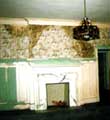 |
|
...Stay inside your house!
|
Moisture Invasion from "within."
As a result, slow leaks at plumbing joints hidden within walls and ceilings can stain ceiling plaster or wallpaper, ultimately rot floor boards, and even lead to decay of structural members! Maintaining and repairing, or, if necessary, replacing older plumbing and mechanical equipment are the most common solutions. Next, condensation produced inside the house can create some real headaches! It's caused when moist warm vapor in the air cools on interior surfaces and changes into liquid. Usually settling on paint, the moist film can result in an unhealthy interior, heavy with mold and mildew spores.
What makes it worse is that the condensation invader is primarily occupant produced! Did you know that a house with four people in it can generate between 10 and 16 pounds of water a day (approximately 1 ½- 2 gallons) from normal, every day activities, such as showering, cooking, and doing laundry? Unvented gas stoves and kerosene heaters also give off a large amount of unwanted moisture. Bathrooms, kitchens, and laundry areas should all have vent fans that are turned on when the rooms are in active use.
When moisture appears as a film on interior window surfaces, it's a sign that you need to take defensive action. In cold climates, install storm windows. This reduces condensation and its damaging effects to historic materials, as well as your health. In summary, reducing condensation through additional ventilation or installing storm windows can really help preserve your historic house!
Replace older pipes that are subject to leaking or overflowing!
Mechanical
equipment: Check condensation pans and drain lines to keep them
clear at all times. Insulate and seal joints in exposed metal ductwork
to avoid drawing in moist air.
Cleaning:
Routinely dust and clean surfaces. Caulk around tile floor and wall
connections and keep floor grout in good condition.
Ventilation:
Reduce household-produced moisture, if it's a problem, by increasing
ventilation, especially in the basement.
Vent clothes dryers
to the outside. Install and always use exhaust fans in bathrooms,
Interior climate
control: Adjust the temperature and relative humidity to manage
interior condensation. Correct areas of improperly balanced pressure
for HVAC systems that may be causing a moisture problem.
|







